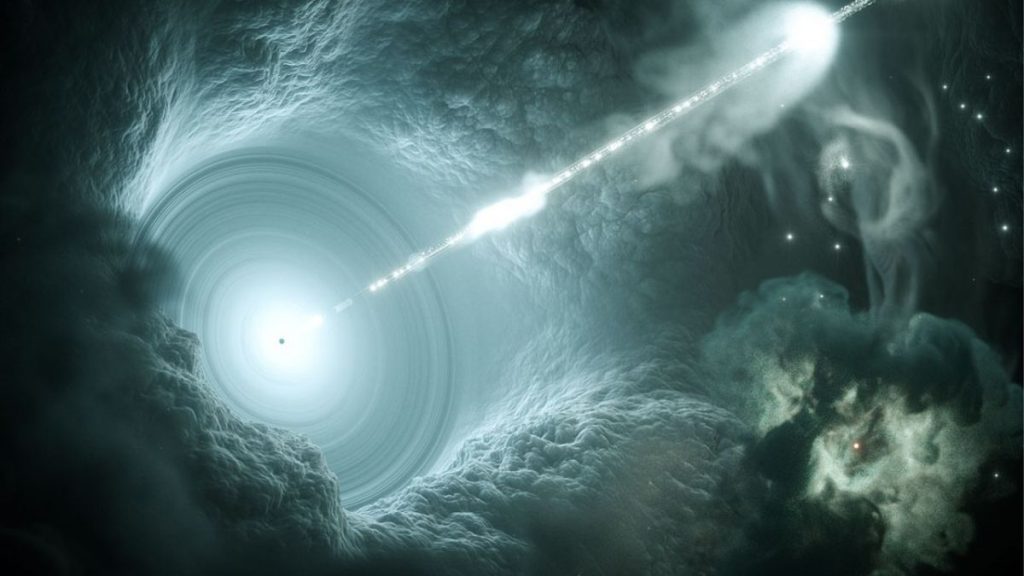
‘Neutrino factories’ could hold the solution to the cosmic ray mystery (Image Credit: Space.com)
New research has revealed that high-energy neutrinos and cosmic rays that bombard the Earth from deep space originate in blazars — actively galactic nuclei (AGN) that lurk at the center of galaxies and are powered by supermassive black holes.
Researchers know cosmic rays are charged particles from deep space that continuously strike Earth with energies as great as 1020 electron volts — a million times more energetic than the energies generated at the Large Hadron Collider (LHC). What could launch these particles with so much force that they travel billions of light-years has, however, remained a mystery.
This is because cosmic rays consist of electrically charged particles, meaning as they journey billions of light-years from their source to Earth, they are repeatedly deflected by the magnetic fields of galaxies, making their sources impossible to spot.
Related: High-Energy ‘Ghost Particle’ Traced to Distant Galaxy in Astronomy Breakthrough
Some of the processes and events that launch cosmic rays also blast out astrophysical neutrinos, and these ‘ghost-like’ particles could be used as ‘messengers’ to solve this puzzle, a team of astrophysicists believes.
“Astrophysical neutrinos are produced exclusively in processes involving cosmic ray acceleration,” team member and Julius-Maximilians-Universität (JMU) Würzburg astrophysics professor Sara Buson said in a statement. (opens in new tab)
Neutrinos are particles with no charge and very little mass that interact with matter so weakly that they pass through galaxies, planets, and even the human body almost without trace. Because they have no charge, neutrinos don’t experience the same deflections as cosmic rays do, meaning their sources can be pinpointed more accurately.
In 2017, a neutrino signal was detected that could be traced back to the blazar TXS 0506+056. As a result, Buson suggested that blazars — which emit more radiation than the entire stellar population of the galaxies around them — are responsible for blasting out high-energy neutrinos.

In 2021, she and her team set about solidifying this connection with a multi-messenger astronomy project, one that mixes ‘traditional’ astronomy with neutrino observations. These new results were achieved using data from the IceCube Neutrino Observatory — the most sensitive neutrino detector ever created — located deep beneath the ice of the south pole in Antarctica.
The team used this data to confirm that the location of blazars corresponded with the direction of astrophysical neutrinos often enough that this association couldn’t be put down to chance alone, providing the first solid evidence of the connection between astrophysical neutrinos and blazars.
“After rolling the dice several times, we discovered that the random association can only exceed that of the real data once in a million trials,” team member and scientist from the University of Geneva’s astronomy department, Andrea Tramacere, said. “This is strong evidence that our associations are correct.”
And because these neutrinos are created in sites where cosmic rays are accelerated and launched, this indicates that blazars are responsible for accelerating cosmic rays too. This could be a result of how the supermassive black hole at the heart of a blazar ‘chews up’ matter like gas and dust that surrounds them before it is ‘fed’ — or accreted — to their surface.
Rotating black holes which drag the very fabric of spacetime along with them , an effect called frame-dragging or Lense-Thirring precession , ensures matter around them can’t stay still, which makes the acceleration of particles easier.
“The accretion process and the rotation of the black hole lead to the formation of relativistic jets, where particles are accelerated and emit radiation up to energies of a thousand billion [times higher than] that of visible light,” Tramacere explained. “The discovery of the connection between these objects and the cosmic rays may be the ‘Rosetta stone’ of high-energy astrophysics.”
According to Tramacere, the next step for this research is to investigate the difference between the types of blazars that emit neutrinos and those that don’t.
“This will help us to understand the extent to which the environment and the accelerator ‘talk’ to each other,” the University of Geneva scientist said. “We will then be able to rule out some models, improve the predictive power of others and, finally, add more pieces to the eternal puzzle of cosmic ray acceleration.”
The team’s findings were published in the journal Astrophysical Journal Letters. (opens in new tab)





